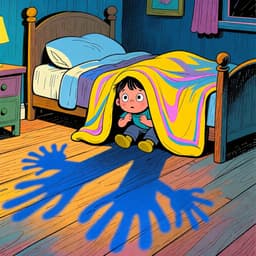I am scared
in SpanishTengo miedo
/TEN-goh M'YEH-doh/
This is the most direct and common way to say "I am scared." It literally translates to "I have fear," and is used universally in all Spanish-speaking regions and contexts.

Whether you're watching a scary movie or facing a real-life fear, 'Tengo miedo' is the perfect phrase to express what you're feeling.
💬Other Ways to Say It
Estoy asustado/a
/ehs-TOY ah-soos-TAH-doh / ah-soos-TAH-dah/
Another extremely common way to say "I am scared." It uses the verb 'estar' (to be) to describe a temporary state of fear. Remember to use 'asustado' if you're male and 'asustada' if you're female.
Me da miedo...
/meh dah M'YEH-doh/
This structure literally means "It gives me fear." It's an incredibly common way to talk about *what* scares you. You always follow it with the thing you're afraid of.
Estoy aterrado/a
/ehs-TOY ah-teh-RRAH-doh / ah-teh-RRAH-dah/
This is a much stronger expression, meaning "I am terrified" or "I am horrified." It implies a much higher level of fear than just being scared.
¡Qué susto!
/keh SOOS-toh/
This is an exclamation that means "What a scare!" or "You scared me!" It's a reaction to a sudden fright, not a statement about an ongoing feeling of fear.
Tengo pánico
/TEN-goh PAH-nee-koh/
This phrase means "I'm panicking" or literally "I have panic." It suggests a loss of control due to overwhelming fear or anxiety.
Estoy acojonado/a
/ehs-TOY ah-koh-hoh-NAH-doh / ah-koh-hoh-NAH-dah/
This is a very common but vulgar slang term used in Spain, equivalent to saying "I'm sh*tting myself" or "I'm scared sh*tless." It's very expressive and informal.
🔑Key Words
Key Words to learn:
📊Quick Comparison
Here's a quick guide to help you choose the best way to say you're scared based on the situation.
| Phrase | Formality | Best For | Avoid When |
|---|---|---|---|
| Tengo miedo | Neutral | General, all-purpose statement of being scared. | Never, this is always a safe and correct option. |
| Estoy asustado/a | Neutral | Describing your state of being scared, often as a reaction. | Never, this is also a universally safe choice. |
| Estoy aterrado/a | Neutral | Expressing extreme fear or terror. | You just mean you're a little nervous or slightly scared; it's too strong. |
| ¡Qué susto! | Informal | A sudden reaction to being startled or surprised. | Describing a long-term or ongoing fear like a phobia. |
📈Difficulty Level
Generally easy. The 'ie' in 'miedo' (M'YEH-doh) can be a small hurdle, but it's very manageable for English speakers.
The main challenge is knowing when to use 'tener' vs. 'estar', and remembering to change the adjective ending for gender ('asustado/a'). The concept of 'having' fear is a key grammatical shift from English.
Usage is quite direct and similar to English, though expressions can sometimes be more dramatic. The main nuance is understanding the difference between a state ('miedo') and a sudden event ('susto').
Key Challenges:
- Remembering to use 'Tengo' instead of 'Soy' or 'Estoy'.
- Matching gender for adjectives like 'asustado/a'.
- Distinguishing between 'miedo' (fear) and 'susto' (scare).
💡Examples in Action
No quiero ver esa película de terror, tengo miedo.
I don't want to watch that horror movie, I'm scared.
Mamá, estoy asustada. Hay un ruido extraño afuera.
Mom, I'm scared. There's a strange noise outside.
A mi hijo le da miedo la oscuridad, así que duerme con una luz encendida.
My son is scared of the dark, so he sleeps with a light on.
¡Qué susto me diste! No hagas eso otra vez.
You scared me! Don't do that again.
Cuando el avión empezó a moverse bruscamente, me quedé aterrado.
When the plane started to move abruptly, I was terrified.
🌍Cultural Context
'Having' Fear vs. 'Being' Scared
The most common Spanish expression, 'Tengo miedo,' literally means 'I have fear.' This is a huge clue about Spanish culture and language: many feelings and physical states are treated as things you 'have' (tener) rather than states you 'are' (ser/estar). Think 'tengo hambre' (I have hunger) or 'tengo sed' (I have thirst). It's a fundamental shift from English thinking.
Expressiveness is Normal
In many Spanish-speaking cultures, expressing emotions like fear, especially in reaction to something, is very normal and not seen as a sign of weakness. Using exclamations like '¡Qué susto!' or '¡Ay, qué miedo!' is a very common and natural way to react in everyday situations. It's often more dramatic than what an English speaker might be used to.
❌ Common Pitfalls
Using 'Soy' for Fear
Mistake: "Saying 'Soy miedo' or 'Soy asustado'."
Correction: Use 'Tengo miedo' or 'Estoy asustado'.
Forgetting Gender Agreement
Mistake: "A female speaker saying 'Estoy asustado'."
Correction: A female speaker should say 'Estoy asustada'.
Confusing 'Miedo' and 'Susto'
Mistake: "Saying 'Tengo un susto' when you mean you are generally scared."
Correction: Use 'Tengo miedo' for a state of fear and 'Me di un susto' or '¡Qué susto!' for a sudden fright.
💡Pro Tips
Choose Between 'Tengo miedo' and 'Estoy asustado/a'
Think of 'Tengo miedo' as describing an internal state ('I have fear inside me'). 'Estoy asustado/a' often describes your reaction to something external ('I am scared because of that noise'). In many cases they are interchangeable, but this little trick can help you decide which one feels more natural.
Specify Your Fear with 'a' or 'de'
To say *what* you're afraid of after 'Tengo miedo,' you can use either 'a' or 'de'. Both are correct and widely used. For example, 'Tengo miedo a las alturas' and 'Tengo miedo de las alturas' both mean 'I'm scared of heights'.
Master 'Me da miedo'
The structure 'Me da miedo + [thing that scares you]' is incredibly useful and will make you sound very natural. Use it for activities (Me da miedo volar - Flying scares me) or things (Me dan miedo los payasos - Clowns scare me). Notice it's 'dan' for plural things!
🗺️Regional Variations
Spain
Spain is famous for its expressive and often blunt slang. 'Estoy acojonado/a' is extremely common among friends but is considered a swear word. The use of 'yuyu' is a fun, colloquial way to express that something gives you the creeps.
Mexico
Mexicans frequently use 'Me da miedo...' to specify what scares them. Diminutives might be used to soften the feeling, like 'Tengo un poquito de miedo' (I'm a little bit scared). The expression 'sacar de onda' is very Mexican and covers being startled, confused, or freaked out.
Argentina
Argentinians, particularly in the Rioplatense region, use very colorful and strong slang. 'Cagazo' is a common, though very vulgar, term for a big scare. The dramatic 'Me muero de miedo' is also frequently used to exaggerate the feeling.
💬What Comes Next?
After you say you're scared
¿Por qué? ¿Qué pasa?
Why? What's wrong?
Es que oí un ruido extraño.
It's just that I heard a strange noise.
You express fear about something
No te preocupes, todo está bien.
Don't worry, everything is okay.
Gracias, necesitaba oír eso.
Thanks, I needed to hear that.
Someone tries to reassure you
No hay nada que temer.
There's nothing to be afraid of.
Lo sé, pero no puedo evitarlo.
I know, but I can't help it.
🔄How It Differs from English
The biggest difference is structural: English speakers 'are' scared, while Spanish speakers most often 'have' fear ('tengo miedo'). This reflects a broader pattern in Spanish where many feelings and states are treated as possessions. Additionally, Spanish has a clearer distinction between a continuous state of fear ('miedo') and a sudden, momentary fright ('susto'), whereas English often uses 'scare' or 'fright' more interchangeably.
False Friends & Common Confusions:
Why it's different: If you mistakenly say 'Soy miedo,' it doesn't compute well. If you say 'Doy miedo,' it means 'I give fear' or 'I am scary.' This is a common mix-up for learners.
Use instead: To say you are scared, use 'Tengo miedo.' To say something or someone is scary, use 'Da miedo' or 'Es aterrador'.
🎯Your Learning Path
➡️ Learn Next:
How to say Don't worry
This is the natural way to reassure someone after they've told you they're scared.
How to say I am happy
Learning to express opposite emotions like happiness helps you build a full range of emotional vocabulary.
How to say Be careful
This phrase is often used in situations that might cause fear, making it a logical conversational partner.
How to say What happened?
This is the most common question to ask someone when they express a sudden feeling like fear.
✏️Test Your Knowledge
💡 Quick Quiz: I am scared
Question 1 of 4
You jump when your friend suddenly taps your shoulder from behind. What is the most natural thing to exclaim?
Frequently Asked Questions
What's the real difference between 'Tengo miedo' and 'Estoy asustado'?
They are very similar and often interchangeable. A good rule of thumb is that 'Tengo miedo' describes a general, internal feeling of fear (like a phobia). 'Estoy asustado/a' often describes your reaction to a specific, external event (like a loud noise). But don't worry too much; in most daily conversations, you can use either one and be perfectly understood.
How do I say something *is* scary, not that *I am* scared?
You can use the phrase 'Da miedo' or 'Es aterrador/a'. For example, 'Esa casa da miedo' (That house is scary) or 'La película es aterradora' (The movie is terrifying). Remember not to say 'es miedo'.
Is it okay for a man to say he is scared in Spanish-speaking cultures?
Yes, absolutely. Expressing fear is a normal human emotion and is not generally seen as unmasculine, especially in informal contexts among friends or family. While cultural norms vary, saying 'tengo miedo' or reacting with '¡qué susto!' is common for everyone.
Can I say 'Estoy miedoso'?
Yes, you can, but it means something slightly different. 'Estoy miedoso/a' means 'I am feeling fearful' or 'I am being timid/skittish' right now. 'Soy miedoso/a' (using 'ser') means 'I am a fearful person' in general. For the simple meaning 'I am scared,' it's much more common to stick with 'Tengo miedo' or 'Estoy asustado/a'.
How do you say 'You scared me!'?
The most common way is to say '¡Me asustaste!' which literally means 'You scared me'. You can also use the exclamation '¡Qué susto me diste!' which means 'What a scare you gave me!'. Both are very natural and widely used.
📚Continue Learning Spanish Phrases
Explore More Phrases in These Categories
Find similar phrases to expand your Spanish vocabulary:
Want to Learn More Spanish Phrases?
Browse our complete collection of Spanish phrases organized by situation, from basic greetings to advanced conversations. Perfect for travelers, students, and anyone learning Spanish.
View All Spanish Phrases →


